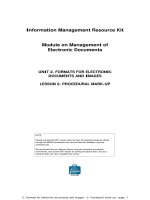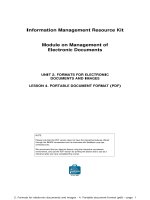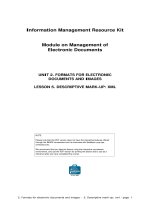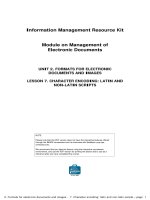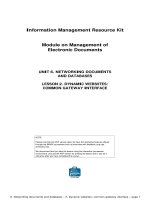UNIT 2. FORMATS FOR ELECTRONIC DOCUMENTS AND IMAGES LESSON 4. PORTABLE DOCUMENT FORMAT (PDF)NOTE potx
Bạn đang xem bản rút gọn của tài liệu. Xem và tải ngay bản đầy đủ của tài liệu tại đây (772.92 KB, 11 trang )
2. Formats for electronic documents and images - 4. Portable document format (pdf) – page 1
Information Management Resource Kit
Module on Management of
Electronic Documents
UNIT 2. FORMATS FOR ELECTRONIC
DOCUMENTS AND IMAGES
LESSON 4. PORTABLE DOCUMENT FORMAT (PDF)
© FAO, 2003
NOTE
Please note that this PDF version does not have the interactive features offered
through the IMARK courseware such as exercises with feedback, pop-ups,
animations etc.
We recommend that you take the lesson using the interactive courseware
environment, and use the PDF version for printing the lesson and to use as a
reference after you have completed the course.
2. Formats for electronic documents and images - 4. Portable document format (pdf) – page 2
Objectives
At the end of this lesson, you will be able to:
• understand when to use PDF format;
• understand the main features of PDF; and
• understand the difference between PDF and
embedded TIFF.
When to use PDF?
I am creating my document using
MS Word, but I have some doubts
about which format to use for its
dissemination…
The best format for document delivery
depends on what you’re doing with the
document.
To create and edit a document,
Microsoft Word can be an appropriate
format.
However, this is not necessarily the best
format for dissemination of documents.
2. Formats for electronic documents and images - 4. Portable document format (pdf) – page 3
When to use PDF?
People have to be able to read and
print the document. Therefore, the
document must display correctly,
regardless of the software and
hardware being used.
Portable Document Format (PDF) is a
procedural mark-up language that allows
page-formatted documents to be viewed
and printed in their original page layout
on almost any software platform.
PDF is the most common format for
exchanging documents where the page
format of the original document must be
preserved.
What is PDF?
The PDF mark-up language is based on an image model, whereby a document contains a set
of pages, which are described by three main object types:
Path objects contain a description of a set of points and the way they
are connected by lines or curves, equivalent to a vector graphic format
(e.g. for displaying computer generated graphics).
Image objects are a rectangular array of image points, equivalent to
a raster graphics format (e.g. for displaying photographs).
Text objects contain a set of glyphs (images representing text
characters), which shapes are described by a separate font.
Now, let’s look at PDF characteristics in detail
2. Formats for electronic documents and images - 4. Portable document format (pdf) – page 4
PDF was created by Adobe
Systems Inc. in the early
1990s.
PDF is based on Adobe’s
PostScript page description
language, but has more
sophisticated features. The
underlying structure of the
document is exposed and
accessible to software
processors. This makes it
easier to support features
such as document
navigation and
hyperlinking.
The figure shows a PDF
document with a navigation
tree of bookmarks.
Features of PDF
This document will be translated in
Arabic, Chinese, Japanese and
Korean. But how will these
characters be displayed?
Because the PDF file contains all the font
information required to render the
document, it is an ideal format for both
scientific documents that contain unusual
symbols, and for multilingual documents,
particularly those using double byte character
sets. It is also useful for mixing different
languages in the same document.
Although HTML or XML documents using
Unicode character encoding support the full
character set required by scientific or
multilingual documents, the display of those
characters will depend on the software
system used to render them, which cannot
be guaranteed to do that correctly.
Features of PDF
2. Formats for electronic documents and images - 4. Portable document format (pdf) – page 5
Features of PDF
A PDF file contains all the information
necessary to render a document on screen
or on the printed page, so that it looks the
same on any computing platform,
regardless of the software packages used
to create and render it.
So a PDF file created on an Apple
Macintosh will look the same to a user of
a PDF viewer on a UNIX workstation or
a reader of the document printed from a
Windows PC.
This feature is called portability.
The following are other important features of PDF:
Features of PDF
COMPRESSION
PDF supports several compression algorithms. This reduces PDF files to minimal size, particularly for transmission
over the Internet.
FONT MANAGEMENT
PDF font management allows font information from the original system that generated the document to be embedded
in the file.
PDF also has direct support for 14 commonly used fonts. These can be used without embedding additional
information.
SECURITY
There are two main security features in PDF. Documents can be encrypted, with different access permissions
assigned to the creator and users of the document, so that they can update, view or print it. Documents can also be
digitally signed so that their authenticity can be verified.
RANDOM ACCESS
The random access of objects in a PDF files means that viewing software can support features such as bookmarks,
thumb-nails, tables of contents, annotation and hyperlinking (both within a document and to external resources).
INCREMENTAL UPDATE
PDF files can be incrementally updated, so that changes are added to the end of the document, rather than being
applied to objects scattered throughout it. This means that large documents can be edited and saved very quickly,
and also ensures that the original content of the document is preserved, no matter how many updates are made.
EXTENSIBILITY
The PDF specification has been designed to be extensible, so that new features can be added, whilst previous
versions remain valid and older software still renders newer versions without error. In addition, applications can store
their own information inside a PDF file, so that it can be processed in a specific way by that application, whilst still
being printable and viewable by other applications (which ignore information specific to any other application).
2. Formats for electronic documents and images - 4. Portable document format (pdf) – page 6
The compression and incremental
loading features of PDF make it well
suited for transmission of documents
over the Internet.
Because Adobe have published the PDF
specification and made the Acrobat
Viewer freely available, you can be
confident as an information creator and
distributor that the users of your PDF
documents will be able to obtain a
Viewer easily and without having to
pay for it.
It seems that this works, since it is
estimated that over 300 million copies
of the Viewer have been downloaded!
The document can be disseminated
through the Internet. People can
connect to the website and download
it.
Features of PDF
Features of PDF
In one sense PDF is an open format: the
PDF specification was published by Adobe
in 1993, at the same time as Adobe
launched the Acrobat suite of products for
creating and viewing PDF documents.
There are now commercial products and
open source software tools available from
many sources other than Adobe.
However, the PDF specification is still
owned by Adobe Systems Inc, who
reserve the sole right to maintain and
extend it, so it is not an open standard in
the same way that HTML or XML are.
If you are interested in further features of
PDF, look at the Adobe website:
www.adobe.com
2. Formats for electronic documents and images - 4. Portable document format (pdf) – page 7
PDF Software Applications
In other applications you can save to another format (such as PostScript), then
use a PDF translator to create PDF.
The most widely used PDF translator is Adobe Acrobat Distiller.
Any application that is able to print documents can also create PDF indirectly by installing a PDF
print driver.
Adobe’s own PDF print driver is called PDF Writer, but there are print drivers available from many
other commercial and open sources.
What do you need to create a PDF document?
PDF files can be created directly by software applications which can direct generate PDF, e.g.
Adobe PageMaker or Corel Ventura.
PDF Software Applications
Adobe Systems, Inc. supply the Acrobat product
suite, which includes Acrobat Distiller, Acrobat
Viewer and Acrobat Capture (which can scan and
convert paper documents to PDF).
There are many other products available from
other vendors for creating, viewing, editing
and printing PDF documents.
Since PDF is also a mark-up language with a
published specification, there are also many
smaller toolkits and utilities available for
processing PDF files or performing specific
functions such as extracting text or breaking into
individual pages. Many of these are available as
open source software. See:
www.pdfzone.com
www.pdfstore.com
2. Formats for electronic documents and images - 4. Portable document format (pdf) – page 8
Embedded TIFF and true PDF
Sometimes, the entire pages of a PDF
document are image objects.
This is the case when a document printed on
paper is scanned and each page is saved as a
TIFF image (a popular raster graphics
format) and then converted to PDF.
This type of PDF is called embedded TIFF.
TIFF
Embedded TIFF and true PDF
However, there are other reasons to use TIFF images.
One would be to preserve an exact replica of the
printed page, including handwritten marks or
annotations that could only be captured properly in a
page image.
Another reason to use TIFF images would be to
prevent users copying or altering the content of
the document. However, the latest versions of PDF
contain encryption and digital signature features that
can achieve this, even with text objects.
Embedded TIFF is not a “true” PDF: only when the page images are converted to a set of PDF
text objects do we have a true PDF.
Embedded TIFF doesn’t allow you to index, search, link, copy and edit the text. In fact many of
the features and capabilities of the PDF format will not work when complete pages are
represented as images.
2. Formats for electronic documents and images - 4. Portable document format (pdf) – page 9
Summary
• PDF (Portable Document Format ) is a procedural mark-up language
that allows page-formatted documents to be viewed and printed in
their original format on almost any software platform.
• PDF is an ideal format for scientific documents that contain unusual
symbols, and for multilingual documents.
• The compression and incremental loading features of PDF make it well
suited for transmission of documents over the Internet.
• Many software packages can be used to create PDF documents, and
PDF viewers are available free of charge.
• A PDF document contains a set of pages which are described by three
main object types: path objects, image objects and text objects.
• Embedded TIFFs are PDF documents where the entire pages are TIFF
images.
Exercises
The following three exercises will help you test your understanding of the concepts covered in this
lesson, and provide you with feedback.
Good luck!
2. Formats for electronic documents and images - 4. Portable document format (pdf) – page 10
For a document that still has to be modified by others.
For a document that has to be displayed and printed in its original
format.
For a document that has to be displayed online.
In which of these situations would you select the PDF format?
Exercise 1
Click on the answer of your choice
A PDF file looks the same on any computing platform.
The size of a PDF file is appropriate for dissemination through the Internet.
PDF documents can be encrypted, with different access permissions.
What does it mean that PDF is a portable format?
Exercise 2
Click on the answer of your choice
2. Formats for electronic documents and images - 4. Portable document format (pdf) – page 11
To disseminate online a journal containing many photographs.
To disseminate online the original copy of a manuscript.
To disseminate online a document that should not be modified.
Click on the answer of your choice
In which of these cases would it be more appropriate to use embedded TIFF rather
than true PDF?
Exercise 3
If you want to know more
Adobe Systems Inc (www.adobe.com) the home of PDF and the Acrobat
product range. You can also download a copy of the PDF Reference.
PDF Reference published (2000) by Addison-Wesley (ISBN 0-201-61588-
6)
Planet PDF (www.planetpdf.com) an independent global resource for
Adobe Acrobat PDF products, tools and information.
PDF Store (www.pdfstore.com) an online store for PDF software products
(linked to Planet PDF).
PDF Zone (www.pdfzone.com) online information source for PDF and
related technologies.
Corel (www.corel.com) home of Ventura, a desktop publishing package
with direct PDF creation capabilities.
Quark (www.quark.com) home of QuarkXpress a desktop publishing
package that can create PDF by saving as Postcsript and using Acrobat
Distiller

